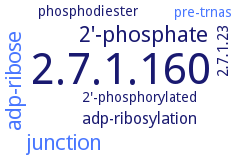2.7.1.160: 2'-phosphotransferase
This is an abbreviated version!
For detailed information about 2'-phosphotransferase, go to the full flat file.

Word Map on EC 2.7.1.160 
-
2.7.1.160
-
2'-phosphate
-
junction
-
adp-ribose
-
adp-ribosylation
-
2.7.1.23
-
phosphodiester
-
2'-phosphorylated
-
pre-trnas
- 2.7.1.160
-
2'-phosphate
- junction
- adp-ribose
-
adp-ribosylation
-
2.7.1.23
-
phosphodiester
-
2'-phosphorylated
- pre-trnas
Reaction
Synonyms
2'-phosphotransferase, ApeTpt1, AtPt, CTHT_0025470, HeLa cell 2'-phosphotransferase, human TRPT1, KptA, kptA1, mTPT1, NAD+-dependent 2'-phosphotransferase, NAD-dependent RNA 2'-phosphotransferase, RNA 2'-phosphotransferase, RslTpt1, Tpt1, Tpt1p, tRNA 2'-phosphotransferase, Trpt1, yeast 2'-phosphotransferase
ECTree
Advanced search results
Engineering
Engineering on EC 2.7.1.160 - 2'-phosphotransferase
Please wait a moment until all data is loaded. This message will disappear when all data is loaded.
R16A/H17A/R64A/R119A
-
site-directed mutagenesis, the R16A, H17A, R64A, and R119A mutations are deemed lethal in vivo
R16A/H17A/R64A/R119A
Runella slithyformis ATCC 49304
-
site-directed mutagenesis, the R16A, H17A, R64A, and R119A mutations are deemed lethal in vivo
-
H117A
H142A
H90A
K16A
-
colony size indistinguishable from that of wild-type TPT1 strain
K69A
-
colony size indistinguishable from that of wild-type TPT1 strain
K69A/R71S
-
this mutant produces a substantial amount of the reaction intermediate
R138A
R138K
-
colony size indistinguishable from that of wild-type TPT1 strain
R158A
-
colony size indistinguishable from that of wild-type TPT1 strain
S91A
T119A
-
colony size indistinguishable from that of wild-type TPT1 strain
Y38A
-
colony size indistinguishable from that of wild-type TPT1 strain
additional information
generation and analysis of diverse mutant strains derived from Saccharomyces cerevisiae strain W303. The essential functions of TRL1 and TPT1 in budding yeast are bypassed by expressing prespliced, intronless versions of the 10 normally intron-containing tRNAs, indicating this repair pathway does not have additional essential functions. Expression of intronless tRNAs fails to rescue the growth of cells with deletions in components of the SEN complex, implying an additional essential role for the splicing endonuclease. The trl1DELTA and tpt1DELTA mutants accumulate tRNA and HAC1 splicing intermediates indicative of RNA repair defects and are hypersensitive to drugs that inhibit translation. tpt1DELTA mutants grow in the presence of tunicamycin despite reduced accumulation of spliced HAC1 mRNA, while failure to induce the unfolded protein response occurs in trl1DELTA cells grown with tunicamycin is lethal owing to their inability to ligate HAC1 after its cleavage by Ire1. Tpt1DELTA phenotype, overview
-
colony size indistinguishable from that of wild-type TPT1 strain
-
colony size indistinguishable from that of wild-type TPT1 strain
-
colony size indistinguishable from that of wild-type TPT1 strain
-
colony size indistinguishable from that of wild-type TPT1 strain


 results (
results ( results (
results ( top
top






